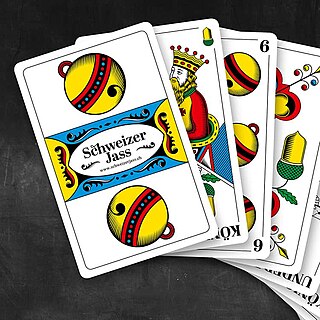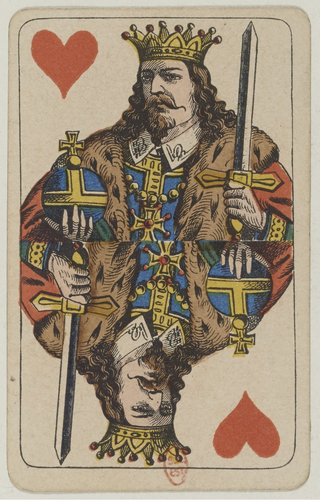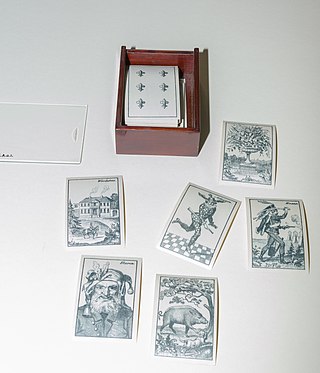
A card game is any game that uses playing cards as the primary device with which the game is played, whether the cards are of a traditional design or specifically created for the game (proprietary). Countless card games exist, including families of related games. A small number of card games played with traditional decks have formally standardized rules with international tournaments being held, but most are folk games whose rules may vary by region, culture, location or from circle to circle.

Tarot is a pack of playing cards, used from at least the mid-15th century in various parts of Europe to play card games such as Tarocchini. From their Italian roots, tarot-playing cards spread to most of Europe, evolving into a family of games that includes German Grosstarok and modern games such as French Tarot and Austrian Königrufen. In the late 18th century French occultists made elaborate, but unsubstantiated, claims about their history and meaning, leading to the emergence of custom decks for use in divination via tarot card reading and cartomancy. Thus, there are two distinct types of tarot packs in circulation: those used for card games and those used for divination. However, some older patterns, such as the Tarot de Marseille, originally intended for playing card games, are occasionally used for cartomancy.

Ombre or l'Hombre is a fast-moving seventeenth-century trick-taking card game for three players and "the most successful card game ever invented."

Gnav is a traditional Danish and Norwegian social game that has been played with either special cards or wooden pieces with similar motifs. Gnav packs appeared after 1820 and the game was popular until c. 1920. The game can be played by 20 or more players, and a minimum of two. Today, only the playing card version is available in Norway.
Minchiate is an early 16th-century card game, originating in Florence, Italy. It is no longer widely played. Minchiate can also refer to the special deck of 97 playing cards used in the game. The deck is closely related to the tarot cards, but contains an expanded suit of trumps. The game was similar to but more complex than tarocchi. The minchiate represents a Florentine variant on the original game.

Chratze is a trick taking card game, mainly played in the German-speaking part of Switzerland as well as in Bavaria. It is one of over 70 variants of Jass and played with a pack of 36 cards, either a Swiss-German or French one. It appears to be related to the Austrian game, Kratzen.

Tarot games are card games played with tarot packs designed for card play and which have a permanent trump suit alongside the usual four card suits. The games and packs which English-speakers call by the French name tarot are called tarocchi in the original Italian, Tarock in German and similar words in other languages.

Zwicken is an old Austrian and German card game for 4 to 6 players, which is usually played for small stakes and makes a good party game. It is one of the Rams group of card games characterised by allowing players to drop out of the current game if they think they will be unable to win any tricks or a minimum number of tricks. Despite a lack of sources, it was "one of the most popular card games played from the 18th to the 20th century in those regions of what is today Austria."
Grosstarock is an old three-handed card game of the Tarock family played with a full 78-card Tarot pack. It was probably introduced into the southern German states around 1720 but spread rapidly into Austria and northwards as far as the Netherlands and Scandinavia. It only survives today in Denmark where it is called Tarok.

Ramsen or Ramsch is a traditional Bavarian plain-trick, card game for three to five players that is played with a 32-card German-suited pack and is suitable both for adults and for children. It is one of the Rams group of card games that are distinguished by allowing players to drop out if they think they will fail to win the required number of tricks. An unusual feature of Ramsen is the presence of four permanent trump cards that rank just below the Trump Sow (Ace). It should not be confused with the contract of Ramsch in games like Skat or Schafkopf, nor with the related game of Rams which is also called Ramsenin Austria, but is played with a Piquet pack, does not have permanent trumps and has a different card ranking.

Mouche, also known as Lanterlu, is an old, French, trick-taking card game for two to six players which has elements, such as bluffing, reminiscent of the much later game of poker. It is a member of the Rams family of games and, although it is a gambling game, often played for small stakes, it is also suitable as a party game or as a family game with children from the age of 12 upwards. It is named after the mouche, a term that variously refers to its winning hand, the basic stake and the penalty for failing to take any tricks. Although also called Bête, it should not be confused with the older game of that name from which it came and which, in turn, was a derivative of Triomphe.
Zwanzig ab, 20 ab or simply Zwanzig is card game for four players. It is a member of the Rams family in which the key feature is that players may choose to drop out of the game if they believe their hand is not strong enough to take a minimum number of tricks. It appears to be a recent, internet-propagated variant of Schnalzen or Bohemian Watten. However, the latter has a natural card ranking, is played with double German cards and a Weli, has no exchanging and has a different scoring system. It is suitable for children from 8 upwards. It may be related from Fünf dazu! which is a simpler game described by Gööck in 1967 that has neither trumps nor the option to drop out.

Knüffeln is a very old trick-taking card game for four players, playing in pairs, that is still played in North Germany. Once considered the national game of Frisia, Knüffeln is a descendant of Karnöffel, the oldest identifiable European card game in the history of playing cards with a continuous tradition of play down to the present day.

My ship sails, also called my bird sings, is an English card game for children that is played with a 52-card French-suited pack in which the aim is to collect a hand of cards in one suit.

Brus is a four-hand card game of German descent that was once played in Denmark and Estonia. The game is descended from the oldest known card game in Europe, Karnöffel, a fact testified by its unusual card ranking and lack of a uniform trump suit.

Drużbart or Druzbart is an extinct Polish card game of the Bruus family. The game is descended from the oldest known card game in Europe, Karnöffel, a fact testified by its unusual card ranking and lack of a uniform trump suit.

Bruus, formerly Brausebart or Brusbart, is a north German card game for four players in two teams of two. It was once highly popular but has since died out except for a few pockets in the state of Schleswig-Holstein. As Brusbart, it was the ancestor of a family of similar games in northern Europe, including Swedish Bräus and Danish Brus which are still played today. Bruus features 'daring and tormenting' which has been said to give the game a certain charm. Once considered the national game of Hamburg, Bruus is a descendant of Karnöffel, the oldest identifiable European card game in the history of playing cards with a continuous tradition of play down to the present day. The game is named after the Bruus or Brusbart, once its top card, but now its second-highest trump.

Coucou ("Cuckoo") is an historical French card game that uses a pack of 32 or 52 cards and is played by five to twenty players. It is unusual for being played with only a single card in hand. As a shedding game, there is only one winner who may claim the stakes, if there are any. The game has also been called As Qui Court or Hère.

Kille, also called Harlequin, Cambio, Campio, Kambio or Kamfio, is a game played with special playing cards, dating from a mediaeval French gambling game. In Sweden, the game had its heyday during the 1750s, but it is one of the oldest card games still played.

Cuccù or Cucù ("Cuckoo") is an Italian card game, over 300 years old, that is playable by two to twenty players and which uses a special pack of 40 cards. It is a comparing game in which there is only one winner, and is unusual in that each player only receives one card.

















